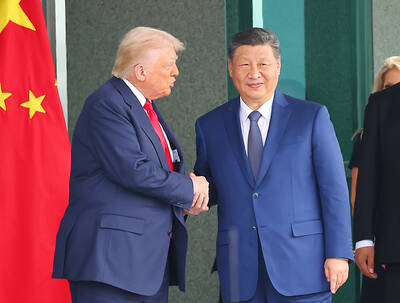US investors are keeping their fingers crossed that the legendary US consumer has not lost his or her appetite for spending ahead of the crucial pre-Christmas shopping season.
Analysts say the approaching week will be of particular importance because the Thanksgiving holiday week traditionally kicks off an annual shopping fest.
Concerns about the health of the US consumer are mounting, however, because of a nagging housing slump, a related credit crunch and surging energy costs.
Whether the nation's malls bulge with shoppers or struggle to get consumers in the door will have repercussions for Wall Street, which has been buffeted by the housing and credit woes.
The Dow Jones Industrial Average stock barometer gained 1.0 percent in the week to Friday to close at 13.176.79.
The broad market Standard & Poor's 500 rose 0.3 percent to 1,458.74 while the tech-rich NASDAQ increased 0.3 percent to 2,637.24.
ON THE ROPES
With the housing and credit markets on the ropes and rocketing crude oil prices making gasoline more costly at the pump, analysts say consumer spending has become even more vital than usual to US economic well-being.
BIG WEEK
"Next week is the big week for the consumer. The market is going to pay a lot of attention to it," said Marc Pado, an equities analyst at Cantor Fitzgerald.
Pado said the stock markets could rise or fall in coming weeks depending on sales reports from big retailers.
US retail sales, which account for around 70 percent of overall economic growth, showed a lackluster gain of 0.2 percent last month, according to a government report on Wednesday. The reading was the weakest since August when sales rose a tepid 0.1 percent.
Economists said they will also be awaiting the release of a consumer sentiment survey next week, published by the University of Michigan, which will reveal clues on whether Americans are maintaining or cutting back their spending.
"The decline in [consumer] sentiment, if sustained, suggests a weak holiday shopping season and is consistent with our view of weaker consumption in the near term," economists at Lehman Brothers said in a briefing note.
The release of minutes from the Federal Reserve's last interest rate policy meeting on Oct. 30 and Oct. 31, and reports on leading economic indicators and the housing market are also on Wall Street's radar for the week ahead.
The central bank cut borrowing costs for the second-straight month last month, by a quarter of a percentage point to 4.50 percent. Economists generally expect the Fed to hold its fed funds short-term interest rate steady at a policy meeting scheduled for Dec. 11.
ECONOMIC RELEASES
The leading indicators, Fed minutes and consumer sentiment survey will be released tomorrow, Tuesday and Wednesday respectively in an otherwise light week for major economic releases.
Bond prices strengthened in the past week as the yield on the 10-year Treasury bond tumbled to 4.150 percent from 4.225 percent a week earlier, and that on the 30-year Treasury fell to 4.523 percent from 4.602 percent. Bond prices and yields move in opposite directions.

RUN IT BACK: A succesful first project working with hyperscalers to design chips encouraged MediaTek to start a second project, aiming to hit stride in 2028 MediaTek Inc (聯發科), the world’s biggest smartphone chip supplier, yesterday said it is engaging a second hyperscaler to help design artificial intelligence (AI) accelerators used in data centers following a similar project expected to generate revenue streams soon. The first AI accelerator project is to bring in US$1 billion revenue next year and several billion US dollars more in 2027, MediaTek chief executive officer Rick Tsai (蔡力行) told a virtual investor conference yesterday. The second AI accelerator project is expected to contribute to revenue beginning in 2028, Tsai said. MediaTek yesterday raised its revenue forecast for the global AI accelerator used

TEMPORARY TRUCE: China has made concessions to ease rare earth trade controls, among others, while Washington holds fire on a 100% tariff on all Chinese goods China is effectively suspending implementation of additional export controls on rare earth metals and terminating investigations targeting US companies in the semiconductor supply chain, the White House announced. The White House on Saturday issued a fact sheet outlining some details of the trade pact agreed to earlier in the week by US President Donald Trump and Chinese President Xi Jinping (習近平) that aimed to ease tensions between the world’s two largest economies. Under the deal, China is to issue general licenses valid for exports of rare earths, gallium, germanium, antimony and graphite “for the benefit of US end users and their suppliers

Dutch chipmaker Nexperia BV’s China unit yesterday said that it had established sufficient inventories of finished goods and works-in-progress, and that its supply chain remained secure and stable after its parent halted wafer supplies. The Dutch company suspended supplies of wafers to its Chinese assembly plant a week ago, calling it “a direct consequence of the local management’s recent failure to comply with the agreed contractual payment terms,” Reuters reported on Friday last week. Its China unit called Nexperia’s suspension “unilateral” and “extremely irresponsible,” adding that the Dutch parent’s claim about contractual payment was “misleading and highly deceptive,” according to a statement

Artificial intelligence (AI) giant Nvidia Corp’s most advanced chips would be reserved for US companies and kept out of China and other countries, US President Donald Trump said. During an interview that aired on Sunday on CBS’ 60 Minutes program and in comments to reporters aboard Air Force One, Trump said only US customers should have access to the top-end Blackwell chips offered by Nvidia, the world’s most valuable company by market capitalization. “The most advanced, we will not let anybody have them other than the United States,” he told CBS, echoing remarks made earlier to reporters as he returned to Washington